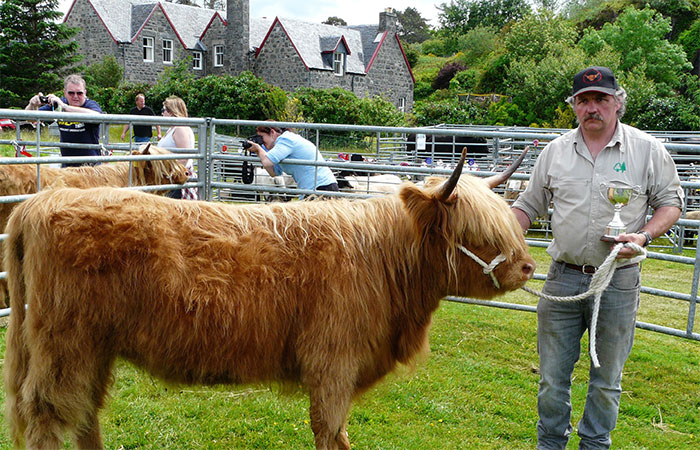
Forestry Commission Scotland use of Highland cattle to manage conservation grazing sites across the National Forest Estate has met with double success.
The Commission’s herd of quality, adaptable, rare-breed Highland Cattle is the core of the project and as well as giving their Lochaber team the chance to let staff demonstrate the effectiveness of conservation grazing techniques, the grazing project has also let them develop some prize winning stockmanship skills.
In the recent show season the team has raked in a haul of 4 cups – and a board-full of rosettes – including awards for Reserve Highland animal at Road to the Isles Show, Champion Highland animal at Sunart Show and Best Highland calf and Best Native Breed calf at Lochaber
In addition to coming under the Uk Woodland Assurance Scheme the Lochaber Cattle meet industry recognised, Quality Meat Scotland and Premium Cattle Health Scheme standards.
Environment Manager Kenneth Knott said: “Using cattle has been a double benefit for us. To people visiting the project we have been able to demonstrate a range of conservation grazing techniques and opportunities for its use; and we have also been able to come to shows to illustrate that trees and cattle can mix very well, delivering quality both in animals and site management.”
The use of cattle lets the Commission redeploy financial and human resources to other programmes and priorities and also negates the need to spend money on specialist habitat management for priority species such as Black Grouse, Chequered Skipper and Pearl Bordered Fritillary butterflies. The key to maintaining site quality is achieved by getting the right animals to the right site at the right time.
Stockman, Sandy Ferguson, said: “The project works on 20 conservation sites every summer and each site has unique characteristics’ and objectives. For instance on certain sites grazing is essential to keep archaeology clear of vegetation but animal size is restricted to protect archaeological artefacts.
“On other sites grazing helps bring through the flowers that butterflies rely on to feed, but cattle have to be removed at a later stage so as not to interrupt the breeding cycle of these rare butterflies.
“Moving animals and matching them to each site as the seasons progress so that we get the best result for each site is an interesting part of the job - it really keeps you on your toes.”
The grazing project was also instrumental in seeing one site - Samhairdh (Savary) – listed as one of Plant Life’s ‘Coronation Meadows’ - a network of traditional wildflower meadows across Britain. The accolade recognises the Commission’s use of traditional techniques to maintain and enhance the site, which as well as providing some winter fodder for the cattle involved in the project, will also provide a rich seed source for enriching other meadows in Inverness-shire.
